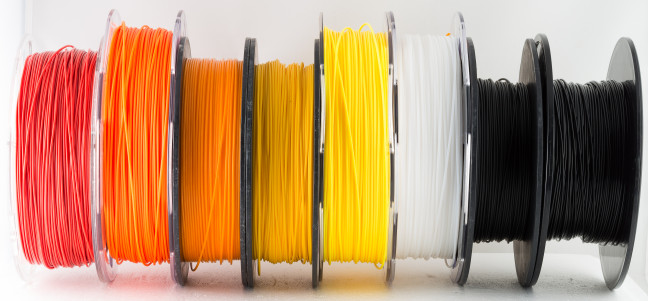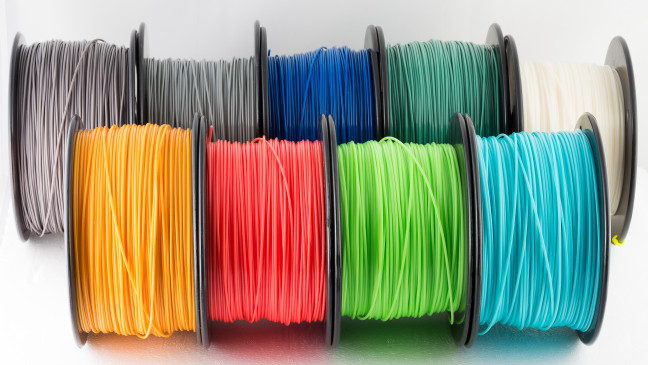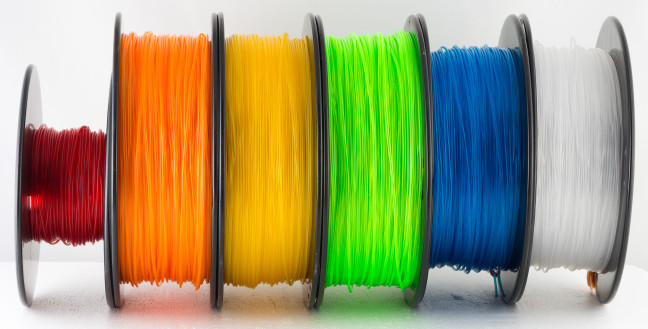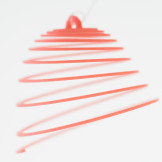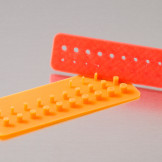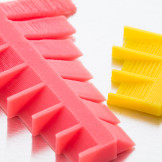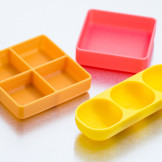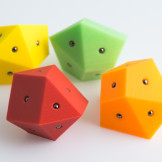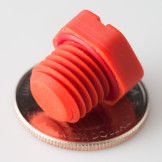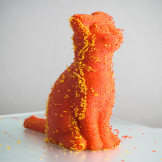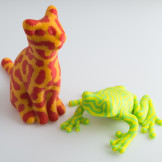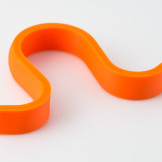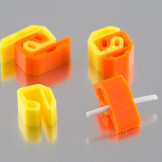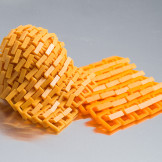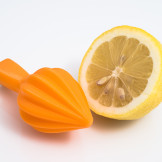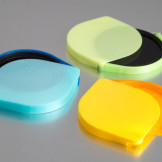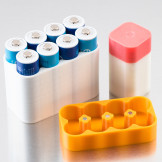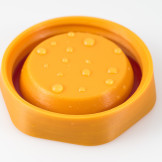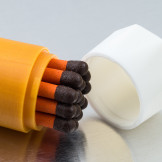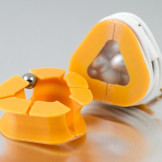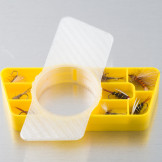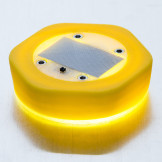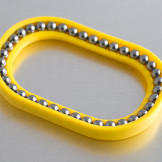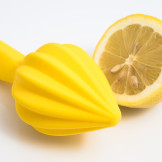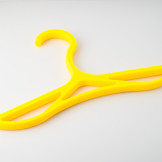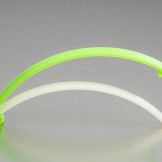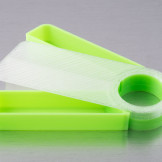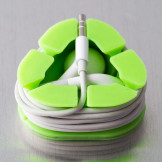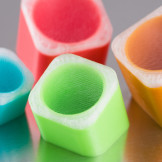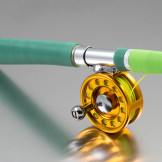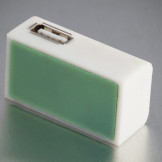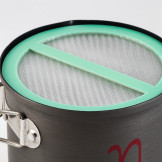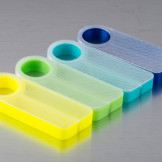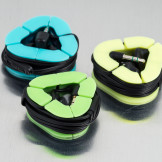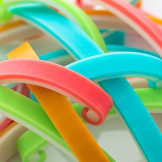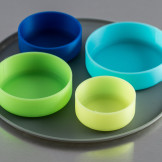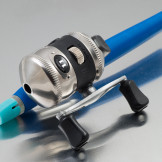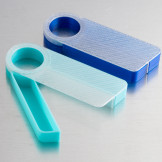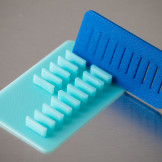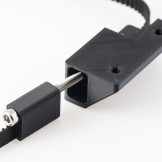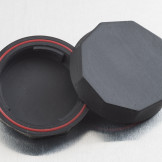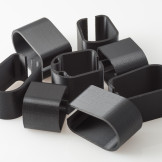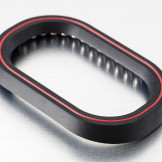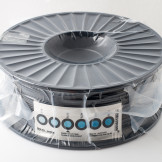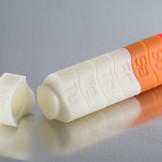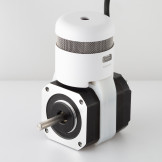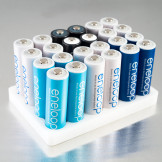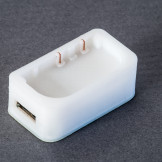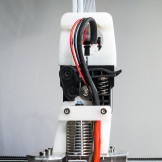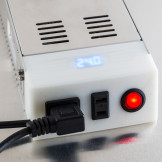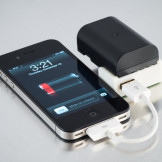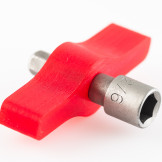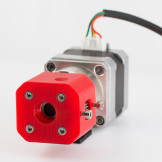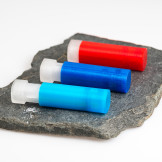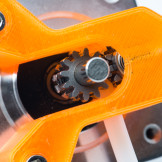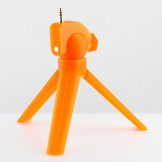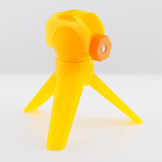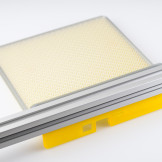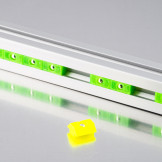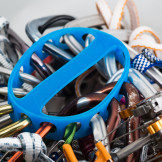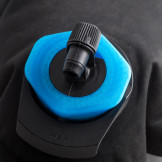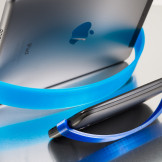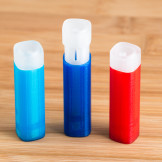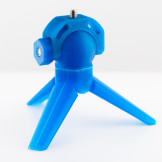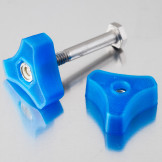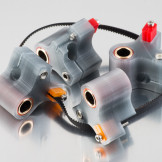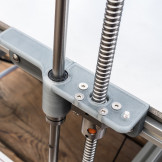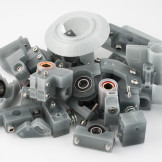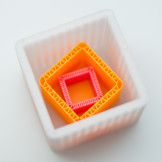For all the people who have asked about filaments, here's my list, spread across 8 different posts. This list includes over a hundred filaments, with pictures, measurements, and impressions. All are 1.75mm. Please don't read too much into my opinions, there's a lot of variation in filament and printers, and my opinions apply only to the spools I have on hand. I try to be objective with these opinions, but my preferences and biases affect my opinion, so keep that in mind when browsing this list. Also be aware of the date, some of these filaments may no longer be available, or may be different from what is currently available. I sometimes describe how I use and print some filaments just to provide another data point, it's likely that your optimal setup will be different from mine.
PLA | ABS | PETG | FLEXIBLE | NYLON | METAL | WOOD | OTHER
Diameter - Diameter readings are taken at several angles, across a meter or more of filament, at whatever part of the spool is currently accessible. Sometimes the filament diameter variation is the result of variations in roundness, and may not have a significant impact on printing performance. I've noticed that I've become less tolerant of filament diameter variation as printers get more precise, inconsistent layers or banding tends to overshadow filament diameter fluctuation. One exception is with transparent filaments, where irregular layers aren't very visible.
Color - It's hard to know the exact color, transparency, and texture of the filament when you're buying online. I'm hoping these pictures along with the descriptions will help you know what you're buying. All the pictures were lit with the same basic setup (unless stated otherwise) so the colors should be somewhat consistent across different types and brands. I have my monitors calibrated, and I try to adjust the pictures to match the actual filament as accurately as I can (which is not very accurately). I don't put the same effort into the example photos or photos that contain multiple spools.
Transparency - Transparency makes a big difference in how these filaments print, but it's one aspect that I hard time getting reliable info on. I'll use the following terms when describing the spooled filament. This info is subjective, the surface finish of the filament will affect the perceived transparency, but it should give you a rough idea.
- very high - Perfectly clear as far as I can tell, ignoring any color.
- high - It's translucent, with a significant amount of fogginess or haziness.
- moderate - It's opaque enough that it doesn't appear to be transparent, but light shines through it fairly easily. If you press a bright flashlight against the spool of filament, about half of the spool will light up. Infill is usually visible through one or two shell layers.
- low - It's opaque enough that you probably won't see your infill showing through, but transparent enough to deemphaasize layer lines. If you press a bright flashlight against the spool of filament, you will see a large halo of light around the flashlight from the light filtering through the filament.
- none - Completely opaque. If you press a bright flashlight against the spool of filament, you will see very little if any light bleeding through the filament.
Printers - I use a Eustathios Spyder v2 and a Rigidbot, both running E3D v6 Hotends. The Rigidbot uses Printrbot gear head direct drive, the Eustathios uses a short bowden setup with a Bondtech extruder (160mm from gear to nozzle). Both are fixed gap, symmetric grip, high torque extruders, so for the most part, all the filaments listed feed without jamming or clogging, (there are a few exceptions, like running metal powder filament through a 0.3mm nozzle or trying to print with cleaning filament). I also used to own an Afinia H-Series Printer (US version of the Up! Plus), only a few of these filaments work well with that printer out of the box. All the example prints have been printed on these three printers. Keep in mind that filament isn't the only factors affecting print quality, choice of printer, experience, print settings, choice of slicer, etc. can have a bigger impact than the filament.
Environment - I'm not sure how much the ambient environment affects printing, but I live in San Francisco Bay Area, California, USA. Temperature and humidity is moderate, indoor temperatures range from a low of 45°F / 7°C in the winter to a high of 80°F / 27°C in the summer with normal temperatures around 65°F / 18°C. None of my printers are enclosed.
Links - There are affiliate links in this list, I may receive a small percentage of the total if you place orders soon after using the links (at no cost to you). I've marked all affiliate links with an asterisk (*). Many thanks to all who have been using these links! Normally I only link to products I'd buy again, but for convenience and completeness, I'm linking all the filaments I can find a reputable source for (even the really bad ones, so read the description). I usually link Amazon* when possible, unless I know of better sources for that particular item.
ABS
Pros
- Good surface finish, usually less glossy than PLA or PETG.
- More flexible and less brittle than PLA.
- Very good temperature resistance (glass transition temperature is over 100°C).
- Support material is easier to remove with ABS than most other plastics.
Cons
- Without an enclosed or heated build chamber, large parts are challenging due to warping.
- Part strength can be unpredictable due to internal stresses and weak layer bonds.
- Tends to be weak along layer bonds.
- Smells bad when printing (some worse than others).
- Only available in opaque colors (see transparent ABS below).
- Turns white under stress.
- Bed adhesion is more challenging than PLA or PETG.
- Warping can make it challenging to maintain accurate dimensions.
Uses
I usually use ABS for smaller parts where warping does not become an issue, or for parts where I need the higher glass transition temperature. I don’t use it for structural parts very often any more unless i need the heat resistance as PETG is usually a better choice. Although I don’t use ABS as much as I used to, I still like ABS for aesthetic reasons, and I tend to prefer the look of ABS over PLA and PETG.
Settings
- 230-240°C Hotend Temperature.
- 90-110°C Bed Temperature.
- Glue stick, two passes right before starting the print. Occasionally I’ll use Suave hairspray if I want a mirror finish on the bottom, but I find corners will often to pull up slightly when printing ABS on hairspray.
Octave ABS* | Fluorescent Red* | 2012
Diameter: 1.66-1.74 | Transparency: Low | Origin: China
I’m not sure how to describe this color, it’s maybe halfway between a pastel pink and a hot pink. The Octave filaments worked well with my Afinia, but I haven’t used them much lately, they tend to smell worse than other filaments (even other ABS).
eSun ABS* | Red | 2014
Diameter: 1.71-1.76 | Transparency: None | Origin: China
Less saturated than the typical red filament, which I prefer (that was the main reason for buying this spool).
2-Color Standing Cat and 2-Color Tree Frog by Nervous System
Honeycomb Drone ABS* | Orange | 2015
Diameter: 1.68 – 1.78 | Transparency: None | Origin: China
This is a nice shade of orange, very similar to the NinjaFlex lava (more red than your typical orange color).
Afinia Value Line ABS* | Orange | 2013
Diameter: 1.70 – 1.74 | Transparency: Low | Origin: ?
Bright orange color.
Octave ABS* | Gold* | 2013
Diameter: 1.70 – 1.77 | Transparency: Low | Origin: China
One of my favorite colors back in my early days of printing, but something in this filament makes the surface a bit rough, as if it had some moisture in it.
Up! OEM ABS* | Yellow* | 2013
Diameter: 1.69 – 1.75 | Transparency: None | Origin: China
Very nice warm shade of yellow, prints well, with a nice finish, but as with other Up! OEM filaments, it requires higher temperatures (I usually use 27o°C).
Honeycomb Drone ABS* | Yellow* | 2015
Diameter: 1.71-1.78 | Transparency: Low | Origin: China
Haven’t really used it much. Good neutral yellow color, nice matte finish on the filament.
Octave ABS* | Fluorescent Green | 2012
Diameter: 1.69 – 1.77 | Transparency: Low | Origin: China
Bright green color, makes it hard to see the layer lines.
Reprapper ABS | Color Changing Green to Yellow | 2013
Diameter: 1.73 – 1.76 | Transparency: None | Origin: China
Color starts off with a dark green/teal color, but it gets lighter when printed, and the higher the temperature the more it shifts. Parts printed in this filament do not age well, they tend to turn an unattractive green-grey color as the pigment degrades. The unprinted filament has not degraded so I’m not sure what is causes the color to degrade.
Octave ABS* | Glow in the Dark Blue* | 2012
Diameter: 1.70-1.82 | Transparency: Low | Origin: China
This filament glows, but not enough to be interesting as a glow filament. And as you can see from the picture, it looks like it has green glow powder instead of blue. The color of the filament is a baby blue color, so you might want it for the color if not for the glowing. The filament and the prints don’t have the same grainy surface I’ve seen with other glow filaments (probably because it has much less glow powder).
Octave ABS* | Blue* | 2012
Diameter: 1.68 – 1.79 | Transparency: None | Origin: China
A slightly darker shade of blue.
Diameter: 1.70 – 1.80 | Transparency: None | Origin: USA
This filament prints well, it works better than the spool of Octave black I had used previously (better surface finish and layers). I was surprised to see so much diameter variation with this spool.
Up! OEM ABS* | Black* | 2013
Diameter: 1.72 – 1.76 | Transparency: None | Origin: China
Prints with a very flat matte finish, a very different look from any other black filament I’ve used. As with other Up! filaments, it runs hotter than normal, I usually print around 270°C.
Atomic Filament ABS | Gun Metal Gray | 2015
Diameter: 1.70 – 1.74 | Transparency: None | Origin: USA (CA)
Warmer in color than the Atomic gun metal gray PLA (I prefer the neutral color of their PLA). Came vacuum packed with a humidity meter which was a nice touch.
Reprapper ABS | Color Changing Grey to Natural | 2013
Diameter: 1.69 – 1.72 | Transparency: None | Origin: China
Dark grey in color, changes to ivory with heat. The color changing additive degrades after printing, so the color doesn’t come out as dark or as consistent after printing. Higher temperatures result in lighter prints. Color continues to degrade over time, resulting in an unattractive, faded print (unless you’re going for that look).
Octave ABS* | Gray* | 2013
Diameter: 1.68 – 1.73 | Transparency: None | Origin: China
Middle to light gray color.
Octave ABS* | Natural* | 2013
Diameter: 1.73 – 1.76 | Transparency: Moderate | Origin: China
Normal natural ABS color, which is closer to ivory than white and slightly transparent. The transparency does a good job of hiding layer lines. One of the better printing Octave ABS filaments.
Honeycomb Drone ABS* | White* | 2015
Diameter: 1.72 – 1.76 | Transparency: Moderate | Origin: China
Very neutral white with no detectable color cast. It is more transparent than most white filaments, and does a good job of hiding layer lines. It looks a lot like the Up! white filament. The filament itself seems more brittle than other ABS filaments.
Up! OEM Filament* | White | 2012
Diameter: ? | Transparency: Moderate | Origin: China
Very neutral white with no detectable color cast. One of my favorite filaments for the Afinia. Like other Up ABS filaments, it prints at 270°C. No pictures or measurements as I don’t have an open spool on hand.
Afinia Value Line ABS* | Glow in the Dark Green* | 2013
Diameter: 1.66 – 1.68 | Transparency: Low | Origin: ?
The filament is a slightly grayish white color, glows brightly and for a long time when exposed to light.
Transparent ABS
I put transparent ABS in a separate category as the filaments I’ve used behave very differently from traditional ABS and I consider them to be different plastics. In general I find transparent ABS warps less, is much more fragile, and performs very poorly under tensile stresses (a small amount of stress will often generate stress fractures and eventually result in a broken part). Even using a spool clip will often break the filament.
Pros
- Seems to warp less than regular ABS
- Glass transition temperature similar to ABS
- Good surface finish
- Looks less like filament prints if printed at a true 100% infill.
Cons
- More fragile than ABS or PLA
- Very susceptible to cracking or breaking under stress, not good for long term use under load
- Even a small load on the filament will cause it to break over time.
Uses
The main reason I use transparent ABS is purely aesthetic, I like the way it looks, especially when it’s printed at 100% infill. The colors are usually very clean, without any strange color casts. As a functional plastic, you should probably use something else, but if you need the extra temperature range and less warping than ABS, transparent ABS may be a decent option. I have used it for printer parts, but mainly because I think it’s one of the more attractive plastics and it’s easier to print large than regular ABS (I wouldn’t recommend doing this though, as the parts tend to break).
Settings
- Hotend Temperature: 240°C
- Bed Temperature – 100°C
- Bed Adhesion – Gluestick, though I’ll occasionally use hairspray if the part is small enough and I don’t think bed adhesion is an issue.
Hatchbox ABS* | Transparent Red | 2014
Diameter: 1.69 – 1.77 | Transparency: High | Origin: ?
Saturated pure red color. Most of this diameter variation seems to be coming from ovality. This particular color seems more susceptible to warping-induced layer cracking than the other transparent ABS filaments I’ve used.
3D Solutech ABS* | See Through Orange* | 2015
Diameter: 1.69 – 1.75 | Transparency: High | Origin: ?
Pure orange color. Claims it’s made in the USA.
Hatchbox ABS* | Transparent Yellow* | 2015
Diameter: 1.70 – 1.78 | Transparency: High | Origin: ?
Nice warm yellow color.
3D Solutech ABS* | See Through Green* | 2015
Diameter: 1.70 – 1.76 | Transparency: High | Origin: ?
Very bright fluorescent green color, glows under UV light. Claims it’s made in the USA.
Hatchbox ABS* | Transparent Blue* | 2014
Diameter: 1.73 – 1.78 | Transparency: High | Origin: ?
More cyan than blue.
3D Solutech ABS* | See Through Blue* | 2015
Diameter: 1.70 – 1.76 | Transparency: High | Origin: ?
Closer to cyan than your typical blue. Claims it’s made in the USA.
Hatchbox ABS* | Transparent Black* | 2015
Diameter: 1.66 – 1.75 | Transparency: High | Origin: ?
Very lightly pigmented, I’d call it more of a smoke color. When printed thin, it’s very similar to clear ABS, but prints with an attractive translucent grey color if printed at 100% infill. I was able to print some large parts with minimal warping using this filament, I don’t think I could have done that with normal ABS. This is one of my favorite colors, I’m glad it’s finally available in 1kg spools.
Invent-a-part ABS | Clear | 2014
Diameter: 1.69 – 1.74 | Transparency: High | Origin: ?
Prints better than a spool of Reprapper clear ABS that I was using previously. The Reprapper clear ABS had a glass transition temperature well below 100°C and would warp if the bed was too hot (I didn’t have real control over the heated bed temperatures with the Afinia) .
Notes on filament brands:
Atomic Filament - They target 1.72mm as the average diameter of their 1.75mm filament (according to their FAQ) so that's usually a good default diameter for their filament, their PLA is usually consistent enough that you don't have to measure each spool. All their filaments are made in California (moved to Indiana in 2017) and they help support this site.
Colorfabb PLA/PHA* - The extra flexibility of PLA/PHA is great for thin, small, or flexible parts that would be too fragile to hold up with regular PLA. It also prints with a satin finish that looks better than the glossy finish I usually get with PLA. Despite the PHA content, I classified PLA/PHA with the other PLA filaments as these differences are fairly subtle and it prints with similar settings.
eSun* - eSun filament is sold and sometimes rebranded by a lot of different sources and I don't know if there are differences between them other than the different spool styles. For this list, I assume they're the same. Microcenter's Inland filament is currently eSun filament and the cheapest place I've found for it (if you don't account for shipping). They also sell Inland* filament on Amazon with free prime shipping. Most of the eSun filament in this list is from Intservo*, who sells on Amazon, but I have also ordered from Microcenter* and Prototype Supply*.
Inland Filament* - I assume all the Inland filament is from eSun (see eSun above) and I've mostly linked to Inland spools because it's cheaper and I prefer the solid black spools.
Honeycomb Drone* - Some spools are advertised as 3lb spools, but are standard 1kg spools. Prices fluctuate on Amazon, I've seen prices under 10 and over 40 USD. The spools I ordered were between 9 and 14 USD.
3D Solutech* - Proudly claims that "All our materials are purely grow and made in the USA", but the spools and the labels under their stickers are identical to other filament I own that came from China.
Places to buy filament:
Amazon* - One of the best places to buy filament, I believe they even accept returns if you don't like the filament (I haven't tried that myself, that's partially why I have so much of it).
Printed Solid - They only sell the good stuff (Colofabb, Taulman, Fenner Drives, Polymaker, etc.), and are kind enough to send me some samples to try occasionally. They sell filament samples which are great for trying out some of the more expensive filaments. They also have a store on Amazon*.
Atomic Filament - Good filament, free shipping, made in California. I check their site often as they're adding new colors / types regularly.
Microcenter - Good place to order eSun (branded as Inland) filament if you have a store nearby or are ordering large quantities (Shipping where I'm at starts at $6 and increases by $1 per spool). They also sell on Amazon* with free prime shipping.
